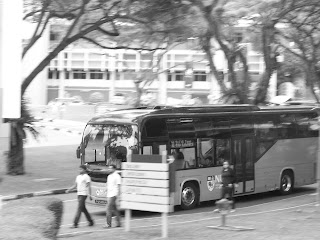First tutorial! I was late for 10 minutes or so, but I was glad I did not miss attendance taking. Lionel was guest speaking again, teaching us more techniques in taking photographs with the manipulation of exposure. This time he spoke about panning, a technique of having the subject be in focus, with the subject's surroundings being blur. It sounded so complicated and foreign, but basically it is about using a slower shutter speed, and moving your camera along with the subject to capture a shot full of movement and speed.
Jing proceeded to give us our first class exercise - to capture a panning shot by the end of class. I wandered around the school campus and finally decided to position myself at the first level of the ADM block and take pictures of moving people and vehicles.


I started out with a rather fast shutter speed, so the results were not very ideal because the subject's clarity hardly differed from the background. So I adjusted to a slower shutter speed (1/30)



The results were significantly better! A little more adjustments to the shutter speed and my hand movement, and I finally got what I wanted.

This is what I got at the end of the class. Yay!